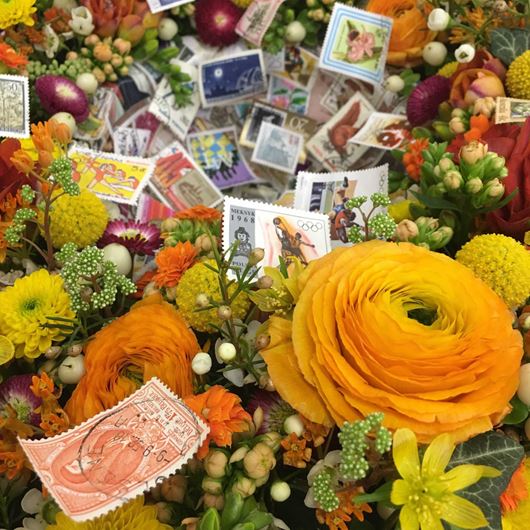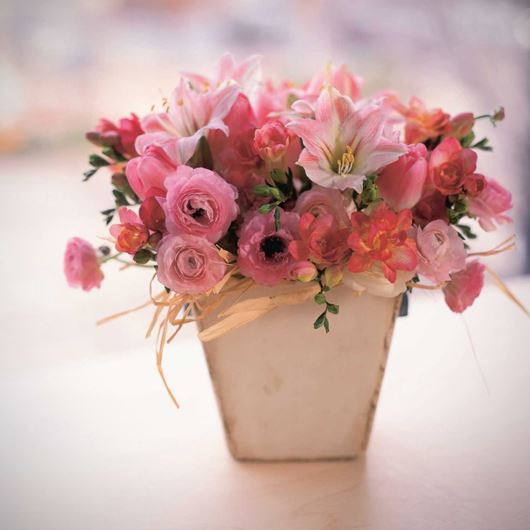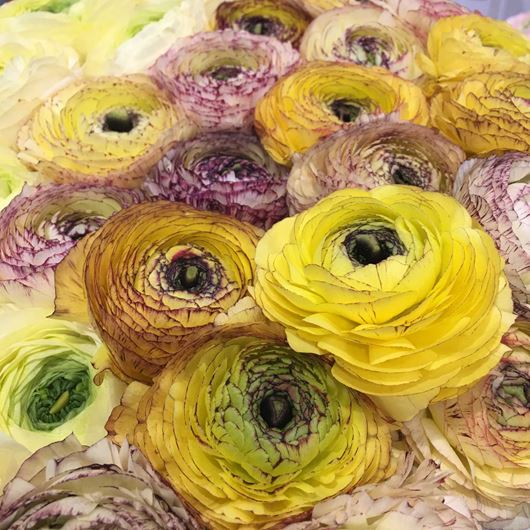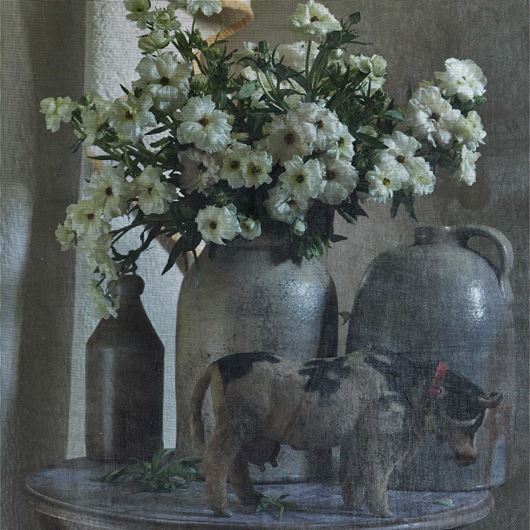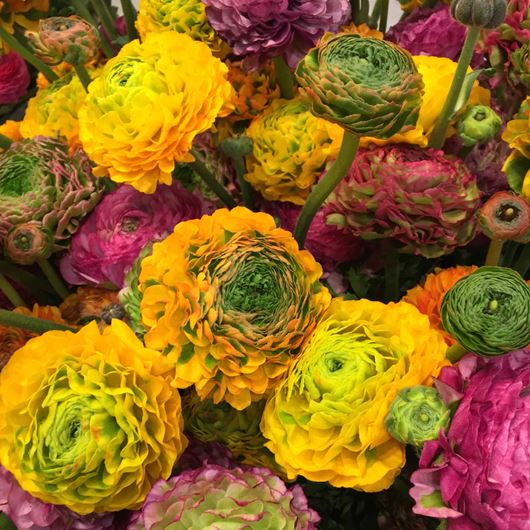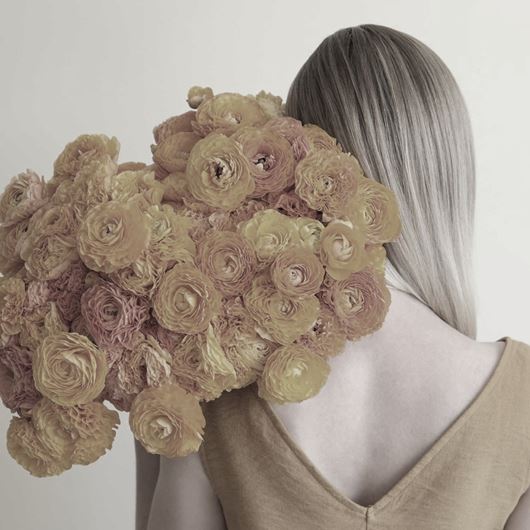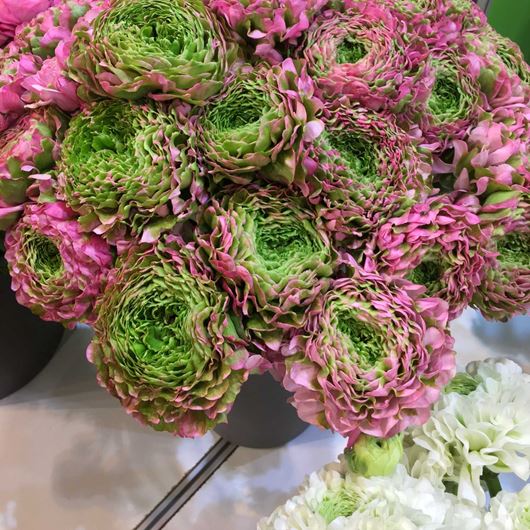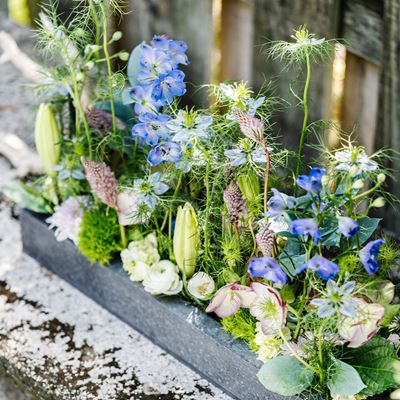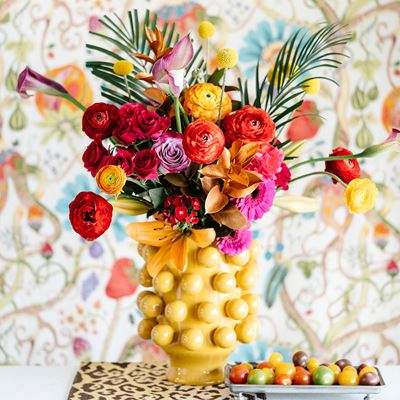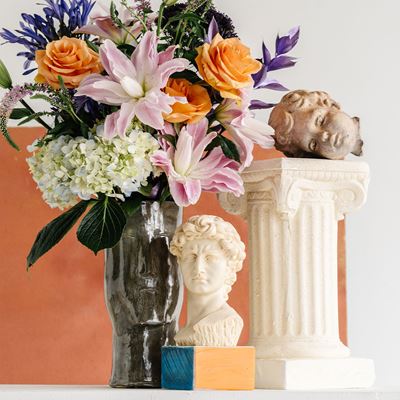Completing our 2023 lookbook series, our sixth and final trend, ATMOSPHERIC, pays homage to our planet's habitats at large. This trending macro view gathers an immersive palette of cool hues, borrowed from the oceans and forests, and pairs it with glowing bright white.
Folkloric Elixir to Pinterest Favorite—So Lands the Charm of the Enigmatic Ranunculus
A wedding crowd and Pinterest favorite, Ranunculus flowers (also known as buttercups) are beloved for their brilliantly colored, paper-thin petals, voluminous blooms and symbolism rooted in love. With origins in the wetland regions of Asia, Europe and Northwest Africa, this herbaceous perennial has transformed from an early ingredient in folk medicine to now become a regular member of high-end flower shops and plant nurseries around the world.
The Ranunculus genus, a member of the Ranunculacea family, includes over 600 varieties of flowering annual and perennial plants. Most cultivars used by contemporary designers are derived from the Ranunculus asiaticus (Persian buttercup) species and are available year-round in a multitude of tones. Its flowers are most commonly recognized by their ample, yet delicate, petals that resemble the texture of crepe paper. The origin of the genus name also boasts an interesting backstory. The word Ranunculus translates to little frog from the Latin words “rana” (meaning frog) and “unculus” (meaning little). It is believed that the name came from the species’ preferred growing regions near bodies of water, and in the spring, they were seen plentiful along streams—just like little frogs.
Historically, Ranunculus played supporting roles in Persian and Native American legends; the flowers were tied to old stories of a lovestruck Persian prince, as well as a Native American coyote whose eyes were snatched by an eagle (read more about these in our FUN FACTS section below). And prior to their modern ornamental uses, Native Americans exploited the plants’ medicinal properties and utilized dried Ranunculus in poultices to remove warts and treat muscle pains. Centuries after its first documented uses, Ranunculus—as a cultivated plant—was introduced to Europe during the reign of Elizabeth I in the 16th century. Today, it remains a much sought-after cut flower among floral artisans, especially for use in wedding work.
A tuberous-rooted plant, Ranunculus stems typically grow to 30 cm in height and feature lush foliage with alternate, fern-like leaves. Topping its stems are loosely clustered, cup-shaped flowers (in either single or double forms) that measure up to 5 cm in diameter, with anthers that are usually black. Most species produce thin, multi-layered petals and come in a rainbow of shades, including red, orange, yellow, pink, purple and white shades. Moreover, what most people don’t know about yellow-colored species in particular is that their smooth petals are highly reflective, somewhat like a mirror. This coloration mechanism helps to attract insects and aids in regulating the plant’s temperature.
Overall, Ranunculus flowers make great pollinator plants and some species also serve as a food source for hummingbirds. However, when eaten fresh, all Ranunculus plants are toxic to humans and animals. Their leaves contain a poisonous compound (called protoanemonin) that when ingested, causes very unpleasant physical side effects. So, a word of caution: Ranunculus is great to look at, but not to eat!
FUN FACTS
• The genus name Ranunculus comes from the Latin words “rana” (frog) and “unculus” (little). It is believed that the name came from the plant’s natural habitat—where it calls streams and other bodies of water home, just like frogs.
• The plant’s epithet means Asia, likely due to the fact that the flower is endemic to Southwest Asia.
• Ranunculus was first introduced to Europe, alongside the anemone and tulip, during the reign of Elizabeth I in the 16th century.
• Ranunculus belongs to the Ranunculaceae (buttercup) family, hence the common names buttercup and Persian buttercup. The name buttercup is also said to be derived from the golden yellow color of the species Ranunculus repens.
• Due to habitat destruction and the influence of invasive species, some Ranunculus species are considered endangered in the wild.
• Ranunculus flowers are easily distinguished by their thin, crepe paper-like petals. They also showcase a nectariferous spot (a pool of nectar) on the bottom portion of their petals. This spot is used to attract pollinating insects and is a feature found only among buttercup-type plants.
• The glossy-yellow buttercup species, Ranunculus repens, is a great reflector of UV light, due to its unique cellular anatomy. Its petals have mirror flat cells that help bounce back light. These flowers were commonly used in children’s games, where kids would hold a buttercup stem underneath their chin—if the flower produced a glowing yellow reflection on the skin, that was said to mean that the person liked butter!
• Among some Native American tribes, Ranunculus flowers were known as Coyote Eyes. According to their legends, they received this name from a mythological coyote. To entertain himself, the coyote would toss his eyes up in the air and catch them again. Suddenly, an eagle swooped down and snatched the coyote’s eyes while they were still airborne. Since he was now unable to see, the coyote grabbed two Ranunculus flowers growing in a nearby field and used them as his new eyes.
• The Persians have quite a different story for the origins of Ranunculus. According to their legends, a young Persian prince became enamored with a beautiful nymph. As a result of his infatuation, he would sing to her day and night. In one version of the story, the nymphs were so tired of the prince’s songs that they turned him into a Ranunculus plant. Another version recounts that the prince died of heartbreak when his love was not returned by his beloved nymph. So, in place of his body, a giant Ranunculus flower sprang up from the ground.
• Native Americans used Ranunculus in herbal medicines. Dried plants were formed into poultices that could remove warts, and treat muscle and joint pains.
• Aside from their obvious outer beauty, many cherish Ranunculus flowers specifically for their symbolic meanings. According to floriography, Ranunculus symbolizes charm and attraction. So, the next time you want to tell someone you are “dazzled by their radiant charm,” given them a bouquet of Ranunculus blooms! These flowers are also a great choice for use in special events that celebrate love, such as weddings, anniversaries, Valentine’s Day, Mother’s Day and others.
• If you are sensitive to floral fragrances, but still want flowers in your home, Ranunculus is the right choice for you! Most varieties are not scented.
• All Ranunculus species are poisonous to humans and animals when eaten fresh. When damaged (or chewed), its leaves release a toxin (called protoanemonin) that can cause burning of the mouth, abdominal pain, diarrhea and vomiting, among other unpleasant side effects. Some species are also toxic to the touch, causing skin to turn red and blister.
• Long ago, people used to believe that the rich, yellow color of butter was caused by yellow Ranunculus plants that were eaten by cows. This, of course, is completely false (given the information that was disclosed in the previous point!). All animals and humans should avoid eating Ranunculus flowers, considering their poisonous traits.
Ranunculus is only one of the Flowers We Love, and we would love to share them all with you. Whether flowers are your passion or your profession, this living encyclopedia will expand your knowledge and entice your imagination. Visit often as we add entries to keep your floral skills growing.
